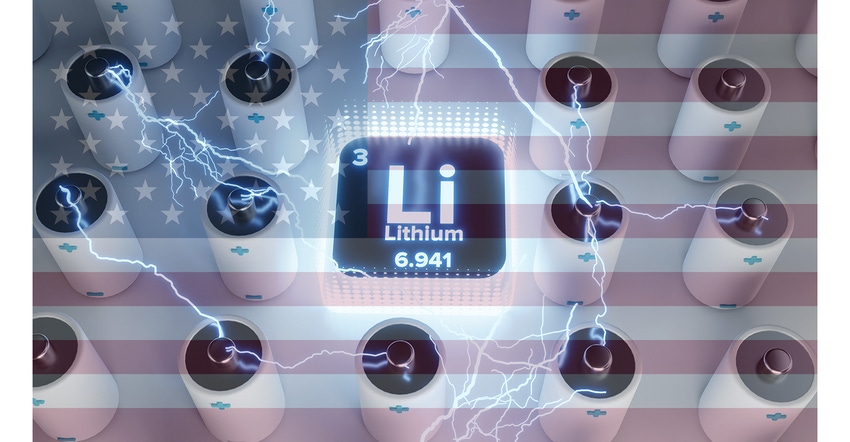How To Get Annual US Lithium Battery Revenues to $33B & Provide 100,000 Jobs by 2030
Li-Bridge, a public-private alliance convened by the US Energy Dept., has a plan to accelerate the creation of a robust domestic manufacturing base and supply chain for lithium-based batteries.
February 15, 2023

Warning that energy storage technology will be as important to this century as the semiconductor chip has been, Li-Bridge, a public-private alliance representing the US battery ecosystem, released today an action plan to accelerate the creation of a robust domestic manufacturing base and comprehensive supply chain for lithium-based batteries. The Li-Bridge alliance was convened by the US Department of Energy (DOE) and is managed by Argonne National Laboratory.
The Li-Bridge report—“Building a Robust and Resilient U.S. Lithium Battery Supply Chain”—includes 26 recommended actions to bolster the domestic lithium battery industry. Underscoring the need to stabilize policy and spur investment, key recommendations in the report include a buying consortium for raw energy materials, a system of shared pilot lines to speed the commercialization of new battery technologies, significant additional investment in battery industry workforce training, and permitting reform.
The report complements a series of recent government initiatives designed to strengthen the country’s battery and semiconductor industries including the Inflation Reduction Act (IRA), the Infrastructure Investment and Jobs Act (known as the Bipartisan Infrastructure Law or BIL) and the CHIPS and Science Act, which together represent some of the most significant industrial policy initiatives in U.S. history.
Collaboration of 40+ companies
Announced in October 2021 by DOE and Argonne, Li-Bridge is spearheaded by three industry trade groups—NAATBatt International, the New York Battery and Energy Storage Technology (NY-BEST) Consortium, and New Energy Nexus—with active involvement from DOE national labs and Boston Consulting Group.
The first collaboration of its kind in the US battery industry, Li-Bridge’s report is a result of collaboration of more than 40 companies, spanning market leaders and startups across the automotive, advanced battery, mining and chemical, and electric utility sectors. Those organizations collectively employ more than 1.2 million people and generate approximately $900 billion in annual revenues.
“This report provides key insights and solutions toward the goal of establishing a resilient domestic manufacturing base and supply chain for batteries, summarizing in-depth discussions between private industry, DOE’s national labs, and federal partners,” stated Argonne Laboratory Director Paul Kearns in a Li-Bridge news release.
Economic, climate, and security objectives
Fueled by exponential demand, lithium-based batteries and the devices they power are major contributors to economic growth in the 21st century, on par with semiconductors. According to the report, if the US cannot establish a secure and stable supply chain for lithium battery technology within its borders, other countries will enjoy the economic growth and job creation that lithium battery technology will create. Today, about 76% of lithium battery cells and the large majority of cell components are made in China.
Lithium-based batteries are also critical for achieving US climate objectives. The report states that without reliable access to lithium battery technology, the US has no chance of meeting its 2050 net-zero carbon emissions goal or ensuring an inclusive and socially responsible industry. With US defense applications increasingly dependent on lithium-based batteries, the report warns of the national security risks in relying on batteries and battery components made abroad.
According to the report, the US will not achieve complete lithium battery supply chain independence by 2030, but it estimates the country can capture 60% of the economic value consumed by domestic demand for lithium batteries by that year, generating $33 billion in revenues and creating 100,000 jobs.
“Although we are starting to see activity in the domestic battery manufacturing sector thanks in large part to the Bipartisan Infrastructure Law and the IRA, US industry is still 10 to 20 years behind Asia, and about five years behind Europe, in commercializing manufacturing of this critical technology,” stated James Greenberger, executive director at NAATBatt International.
“The electrochemical storage of electricity will be as important a technology to the economy of the 21st century as the semiconductor chip has been.”
“We have dozens of start-ups with American-made solutions ready to build an electric future here and abroad with better batteries,” stated Danny Kennedy, CEO at New Energy Nexus. “The IRA, CHIPS Act, and related industrial policy efforts now need to be augmented with a focus on practical steps, such as pilot lines and workforce training, to ensure we’re including people across the country in this opportunity.”
About the Author(s)
You May Also Like





